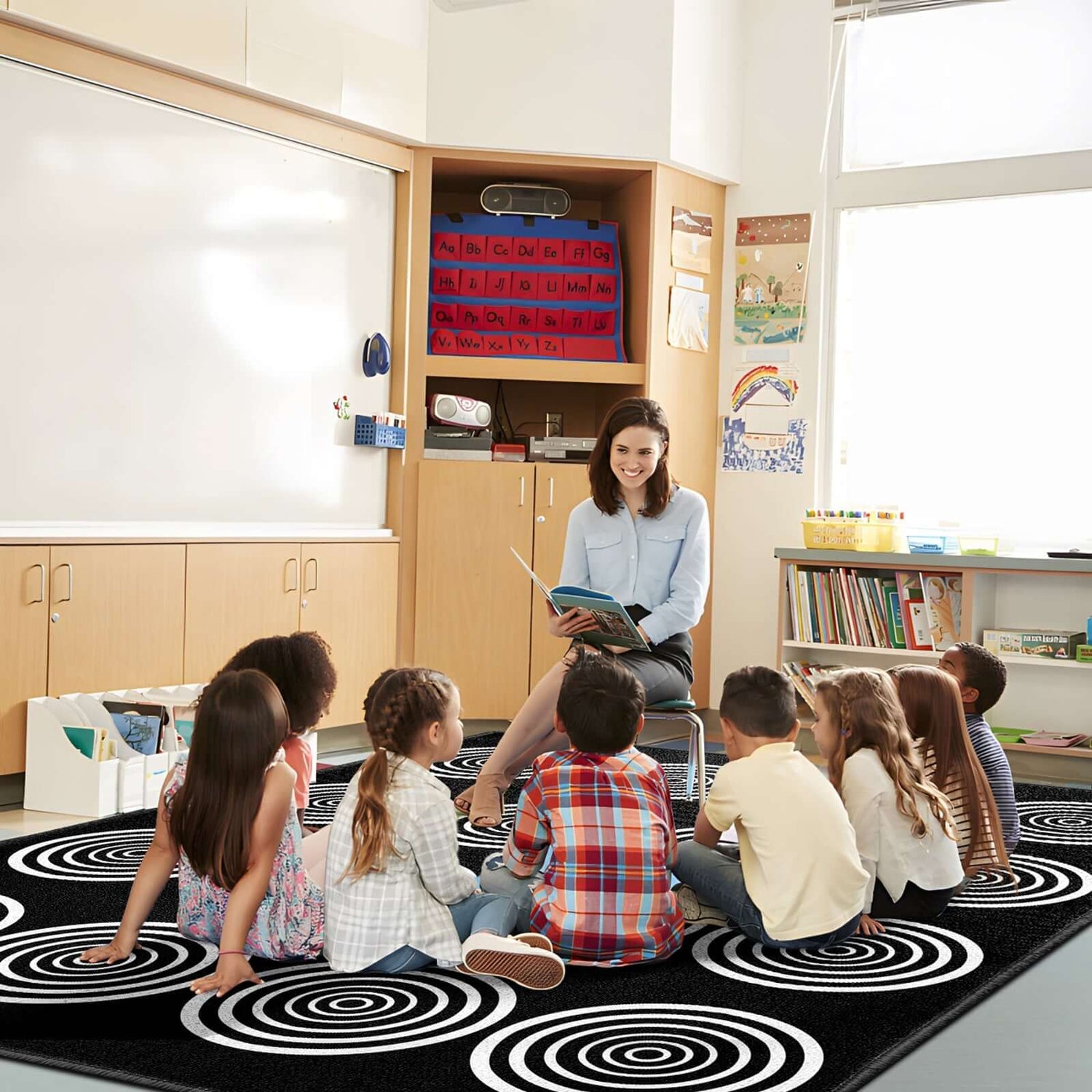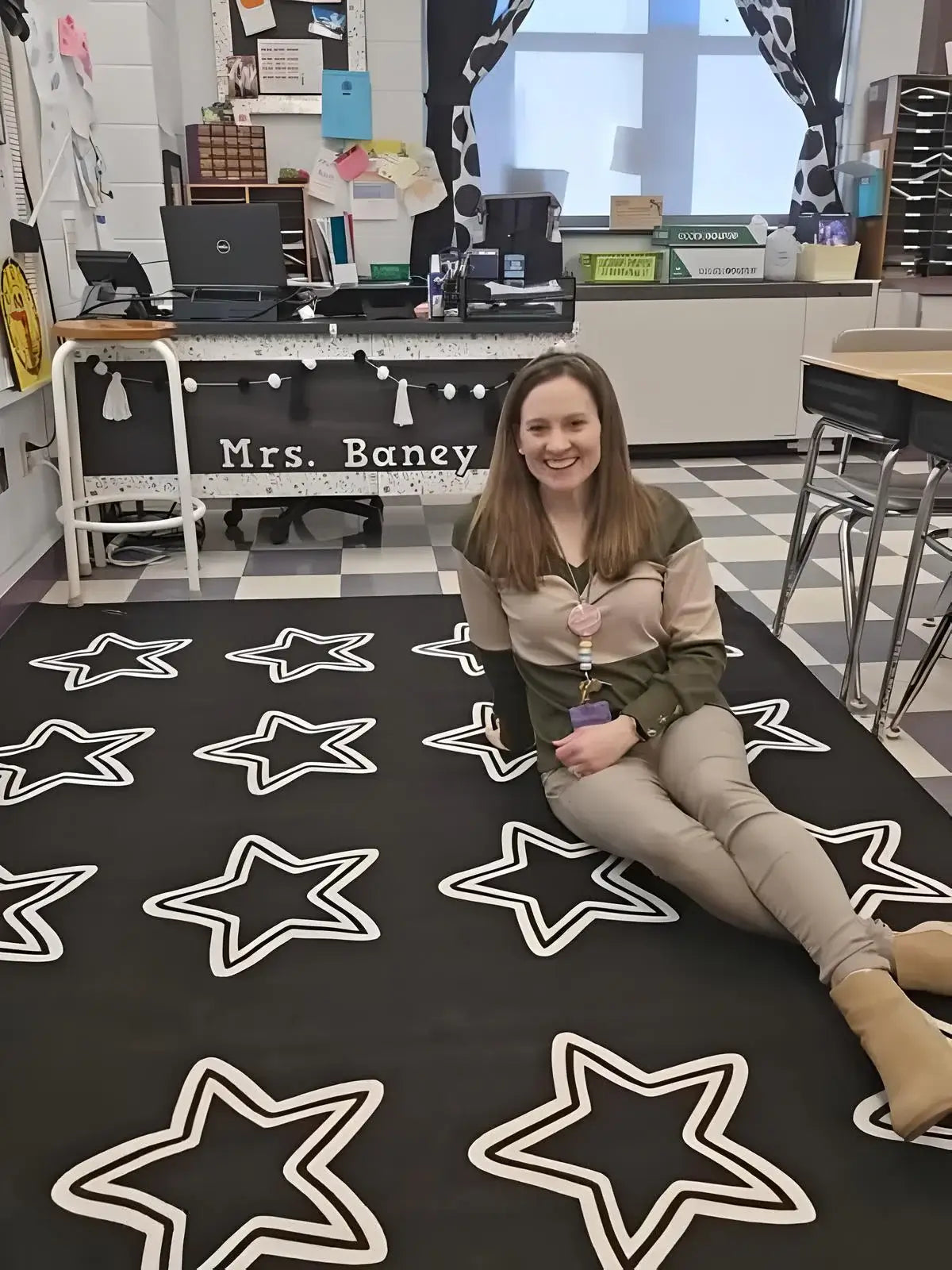The Science Behind Independent Reading Success
Research consistently demonstrates that independent reading time allows students to apply all of the reading strategies and skills that teachers have been teaching them in authentic, meaningful contexts.
According to educational research, independent reading time "allows an adult to model the habits, choices, comments, and attitudes good readers develop." This practice creates readers of the future while building essential literacy skills in the present.
Building Reader Independence Through Environmental Design
Silent reading is incredibly important. This is not just because it gets kids reading now, but because it creates readers of the future.
The physical environment plays a crucial role in supporting this independence, with classroom rugs providing the foundational comfort and defined space necessary for sustained reading engagement.
Essential Elements of Independent Reading Rugs
Comfort-Focused Design Features
Creating a comfortable reading environment by providing cozy seating, warm lighting, and a quiet atmosphere helps students feel relaxed and engaged in their reading.
The right classroom rug transforms hard floors into inviting reading spaces where students can:
- Sprawl out comfortably with their chosen books
- Maintain focus for extended reading periods
- Feel physically supported during independent reading time
- Develop positive associations with reading activities
- Create personal reading rituals that enhance engagement
Quiet Zone Functionality
This is an area in the classroom dedicated to providing a calming, quiet, distraction-free zone.
Students can use the quiet zone to work, read, or think. Effective independent reading rugs should support this quiet zone concept through:
- Sound absorption properties that reduce ambient classroom noise
- Visual boundaries that help define the reading space
- Appropriate sizing for individual or small group use
- Neutral colors that promote calm and focus
- Durability to withstand daily use
Strategic Placement for Maximum Impact
Creating Defined Learning Zones
Learning zones are essentially distinct areas within the classroom that have been purposefully designed to differentiate between different modes of learning and teaching.
Rugs allow educators to reconfigure classroom layouts by activity and experiment with different arrangements to accommodate evolving teaching strategies and student preferences.
Key placement considerations include:
- Corner positioning for maximum privacy and minimal distraction
- Natural lighting access to support comfortable reading
- Proximity to book storage for easy material access
- Distance from high-traffic areas to maintain quiet atmosphere
- Flexibility for reconfiguration as needs change throughout the year
Supporting Multiple Learning Styles
Soft, plush reading rugs are ideal for floor seating, and encourage relaxation and focus during independent work or quiet reading sessions.
These comfortable surfaces accommodate various reading preferences:
- Floor sitting for students who prefer informal positions
- Lying down for recreational reading time
- Cross-legged positioning for focused study sessions
- Movement accommodation for kinesthetic learners
- Sensory support for students with processing needs
Implementation Strategies for Independent Reading Success
Establishing Reading Routines
I start each class period with 15 minutes of silent, independent choice reading. Successful independent reading programs require consistent routines supported by thoughtfully designed physical spaces. Classroom rugs contribute to routine establishment by:
- Providing consistent location cues for reading time
- Creating ritual significance through designated spaces
- Supporting transition management between activities
- Encouraging self-regulation through defined boundaries
- Building ownership over personal reading experiences
Supporting Student Choice and Agency
When students recognize something isn't right, they can comfort themselves using the quiet zone. This self-regulation aspect is crucial for independent reading success. Effective rug-based reading areas should:
- Accommodate individual preferences for reading positions
- Allow for book selection and organization nearby
- Support emotional regulation during challenging texts
- Encourage risk-taking with new genres and authors
- Foster independence in reading decisions
Design Considerations for Different Age Groups
Early Elementary (K-2)
Young learners require reading corner design that emphasizes safety, comfort, and visual appeal. Ideal rug characteristics include:
- Smaller individual spaces to prevent crowding
- Bright, engaging colors that invite exploration
- Alphabet or phonics integration for skill reinforcement
- Easy-clean materials for frequent maintenance
- Cushioned surfaces for extended floor sitting
Upper Elementary (3-5)
Older students benefit from more sophisticated reading environments that support longer engagement periods:
- Larger surface areas for book spreading and note-taking
- Neutral or mature color schemes that feel age-appropriate
- Durable construction for active use patterns
- Modular arrangements that support partner reading
- Technology integration spaces for digital reading tools
Middle School Adaptations
Adolescent learners require reading spaces that respect their developing independence while providing necessary structure:
- Individual territory definition through strategic sizing
- Sophisticated aesthetics that avoid childish appearances
- Flexible arrangements for various reading activities
- Privacy features that support focused engagement
- Integration with study skills development
Maintenance and Sustainability
Practical Care Guidelines
Put away the worksheets and reading logs, and just let them read. While the philosophy of independent reading emphasizes simplicity, the physical environment requires thoughtful maintenance:
- Regular cleaning schedules to maintain hygiene and appearance
- Stain-resistant treatments for longevity and cleanliness
- Rotation systems to ensure even wear patterns
- Student involvement in care and responsibility
- Professional cleaning during breaks and transitions
Budget-Conscious Selection
Many educators face budget constraints when creating independent reading environments. Cost-effective strategies include:
- Multi-purpose designs that serve various classroom functions
- Quality investment in high-traffic areas
- Community partnerships for funding support
- Grant applications specifically for literacy environments
- Phased implementation to spread costs over time
Technology Integration in Modern Reading Spaces
Balancing Digital and Traditional Reading
Put a twist on reading by using audiobooks to hook in students. Keep headphones handy for students who might have a difficult time staying engaged during independent reading.
Modern independent reading environments must accommodate both traditional and digital literacy tools:
- Device-friendly surfaces that support tablets and e-readers
- Charging station access for extended reading sessions
- Headphone storage for audiobook experiences
- Screen-free zones for traditional book engagement
- Hybrid arrangements that support reader choice
Accessibility and Universal Design
Independent reading environments must welcome all learners regardless of ability or background:
- Multiple seating options to accommodate physical needs
- Clear sight lines for supervision and support
- Sensory considerations for students with processing differences
- Language support through multilingual book displays
- Adaptive technology integration for diverse learners
Assessment and Environment Evaluation
Measuring Reading Environment Effectiveness
The most obvious benefit of having a quiet zone is helping students learn to manage emotions. Similarly, effective independent reading environments should demonstrate measurable impacts:
- Increased voluntary reading during choice time
- Extended engagement periods with self-selected texts
- Improved reading confidence and independence
- Enhanced self-regulation during reading activities
- Positive attitude development toward reading
Continuous Improvement Strategies
Successful independent reading environments evolve based on student needs and feedback:
- Regular student input on space functionality
- Observation-based adjustments to layout and materials
- Data collection on reading engagement patterns
- Professional development in reading environment design
- Collaboration with reading specialists and librarians
Creating Collaborative Independent Reading Experiences
Peer Support Systems
While independent reading emphasizes individual choice, peer interactions can enhance the experience:
- Partner reading zones for shared exploration
- Book discussion areas for informal conversations
- Recommendation displays created by student readers
- Mentorship opportunities between older and younger students
- Reading celebration spaces for sharing discoveries
Community Connections
For additional research and evidence supporting independent reading practices, educators can explore resources from the International Literacy Association, which provides extensive documentation on effective reading instruction and environment design.
Future Trends in Independent Reading Environment Design
Innovation and Adaptability
As educational understanding evolves, independent reading environments continue to adapt:
- Flexible modular systems that support changing needs
- Biophilic design elements that connect readers with nature
- Mindfulness integration for enhanced focus and engagement
- Cultural responsiveness in design and book selection
- Sustainability focus in materials and practices
Supporting Lifelong Reading Habits
The ultimate goal of independent reading environments extends beyond classroom walls:
- Transferable skills for home and community reading
- Reading identity development through positive experiences
- Genre exploration and literary appreciation
- Critical thinking enhancement through diverse texts
- classroom management strategies that support independent learning
Professional Development and Training
Teacher Preparation for Independent Reading Implementation
Creating successful independent reading environments requires ongoing professional development:
- Research-based practices in reading instruction
- Environmental design principles for learning spaces
- Student engagement strategies for sustained reading
- Assessment techniques for monitoring progress
- Community building approaches for reading culture
Conclusion: Transforming Learning Through Independent Reading Spaces
The creation of effective independent reading environments represents a fundamental investment in student literacy development and lifelong learning.
Through thoughtful selection and placement of seating rugs , educators can establish the physical foundation necessary for students to develop independence, confidence, and genuine love for reading.
Research consistently demonstrates that students who experience well-designed independent reading programs show improved literacy outcomes, enhanced self-regulation skills, and increased motivation for learning.
The physical environment, anchored by comfortable and appropriate classroom rugs, provides the sensory and emotional support necessary for sustained reading engagement.
As educators continue to recognize the critical importance of independent reading in comprehensive literacy instruction, the design of supportive physical environments becomes increasingly vital.
Quality classroom rugs serve not merely as floor coverings, but as foundational elements in creating the calm, comfortable, and inviting spaces where lifelong readers are nurtured.
Whether implementing a new independent reading program or enhancing existing literacy environments, the strategic use of classroom rugs offers an accessible and impactful approach to supporting student reading development.
Through careful attention to comfort, functionality, and design, educators can create independent reading sanctuaries that inspire students to explore the limitless worlds available through books.




Leave a comment
This site is protected by hCaptcha and the hCaptcha Privacy Policy and Terms of Service apply.